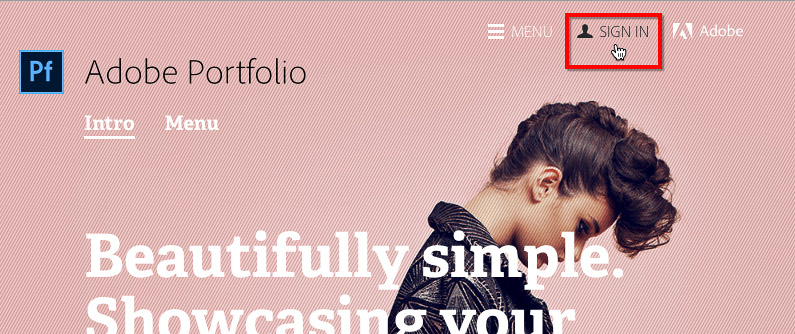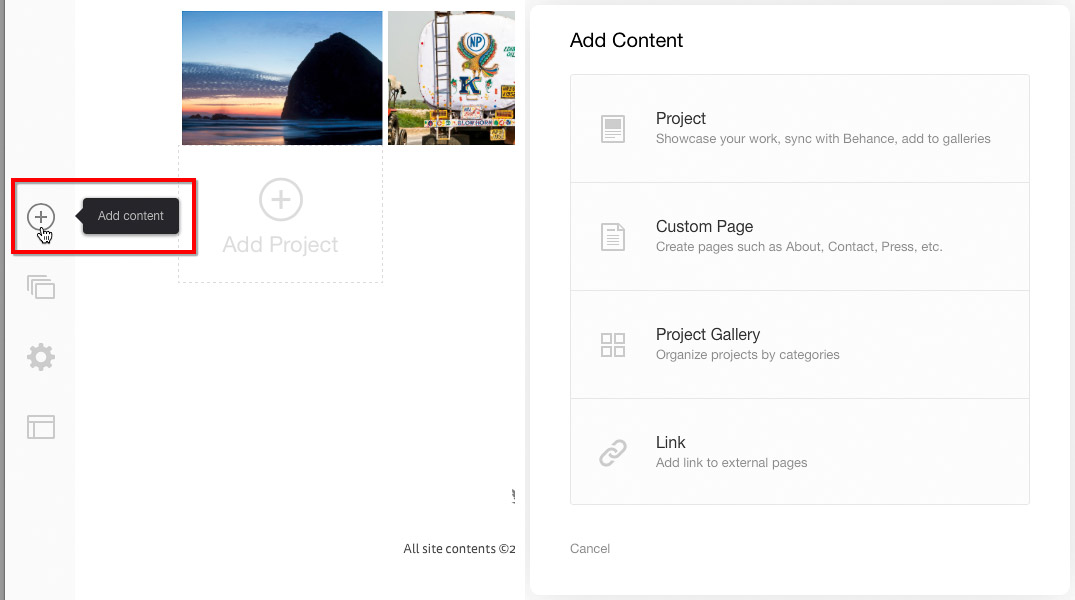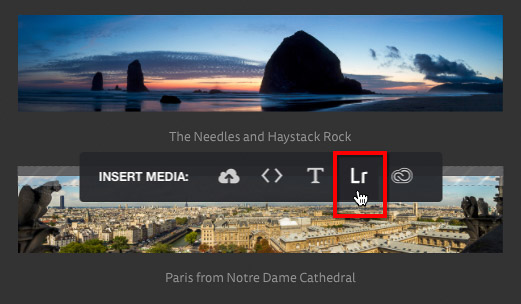How To Stop A Template You've Started In Adobe Portfolio
Using Adobe Portfolio
If "build my website" is still on your To Do list and yous're an Adobe Creative Cloud fellow member, Adobe Portfolio might be your side by side end. Adobe Portfolio is a web-based service that lets you build a website for your all-time photography, pattern, video, and other creative work. Portfolio is neither the start nor the near characteristic-rich of the many web-based site builders. Merely information technology'due south well targeted to Creative Cloud members who demand a quick, easy way to get a focused body of work online.
Adobe Portfolio replaces the ProSite online portfolio service that originally came with the Behance creative social network acquired past Adobe. Portfolio and Behance are Artistic Deject services for presenting your piece of work and interacting with the artistic community online. Adobe Portfolio isn't a desktop or mobile awarding; you use it in a web browser. You lot start it up by signing into myportfolio.com with your Adobe ID.

As with other Creative Cloud services, you sign in to Adobe Portfolio with your Adobe ID.
Is Adobe Portfolio the Correct Choice for Your Website?
Browser-based website builders are null new; nosotros've covered quite a few on CreativePro (run across All-time Websites for Graphic Design Portfolios and Choosing a Website For Your Photos). With then much choice out there, why consider Adobe Portfolio? Costless sites tend to testify ads and have limited pattern command, while characteristic-rich sites without ads typically accept a significant monthly or annual fee.
Adobe Portfolio doesn't have ads and gives you a fair amount of creative control, and the templates are designed well plenty that creative professionals won't be embarrassed to testify their work on them. And if you're an Adobe Creative Cloud member, in that location is no additional charge for using Portfolio.
More after the spring! Continue reading beneath ↓
Free and Premium members see fewer ads! Sign upward and log-in today.
Adobe Portfolio is a good choice if you desire to:
- Rapidly and easily create a website for your creative work without writing code
- Use your own domain name
- Add buttons for your social media feeds, such as Instagram and Twitter
- Sync projects between Adobe Portfolio and Behance
- Utilise Typekit fonts
- Upload content you already have in Lightroom Mobile and Creative Deject file storage
- Clarify site traffic using your Google Analytics account
On the other mitt, Adobe Portfolio isn't a good fit if you lot desire to:
- Pattern or install boosted themes
- Edit CSS, PHP, or JavaScript code
- Provide non-public services to clients, such every bit private proofing/review galleries or impress fulfillment
- Sell from the site
- Blog from the site
- Upload and manage thousands of images from your photographic camera
If you demand more than than Portfolio offers, depending on your skill level y'all tin can build your website using Adobe Muse or Adobe Dreamweaver which are too included with a Creative Cloud membership. You can too attempt one of the browser-based website builders in the CreativePro articles mentioned earlier. Because Portfolio is a spider web-based service, its capabilities may modify equally Adobe improves the service over fourth dimension.
Planning an Adobe Portfolio Site
The basic units of a Portfolio site are Projects, Project Galleries, Custom Pages, and Links. Creating your Portfolio site goes much faster if yous previsualize and organize your content along these lines before you offset working in Portfolio.
Projects are sets of your piece of work, while Project Galleries are like categories under which yous can organize those sets. The terminology can exist a piddling confusing if you think of a "gallery" as a container for individual works, because in Adobe Portfolio, "gallery" means a container of projects, not of private works.

This is how Adobe Portfolio terminology corresponds to the parts of a typical portfolio website.
You can use Custom Pages for other purposes, such as the About folio or Contact page that you see on many websites. For instance, on an About page yous might blazon a paragraph about yourself along with a photo that yous upload. A Link lets you lot ship visitors to a URL you enter, such equally your online store.
Working with Layouts
Portfolio offers a selection of site designs, or layouts; you can run into a demo of each layout on the Portfolio site. Layouts are similar to what other website builders call themes. The range of styles is express, only y'all tin can differentiate your Portfolio website by customizing background images, margins, spacing, colors, rollovers, site icons, fonts, and other details. Yous can switch layouts at whatever time while keeping all of the content you entered.

I change my 2-column gallery layout (top) to 4 columns (bottom). The space between thumbnails is prepare by Margins sliders in the Cover Images panel which isn't currently visible.
If you're accustomed to other browser-based website builders that let yous install more themes or design your own themes, that isn't available in Portfolio. On Projection or Custom pages y'all tin can insert media in any order, but they'll flow in a single column. Adobe Muse and Dreamweaver provide much more than command over folio layout, but Portfolio is easier to utilize.
Preparing Media
Yous can add content to a Portfolio projection in many ways: Upload files from your computer, embed iframe content tags from sites such as YouTube and Google Maps, or import photos synced with Lightroom Mobile. Y'all tin can also import straight from your Creative Cloud Files (certificate storage), but non from Creative Cloud Libraries. The Add Course push button inserts a complete contact form in one click.

The Add together Media console provides many ways to bring content into a Portfolio website.
In my tests, if an paradigm is 1920 pixels broad or larger, Portfolio serves it at 1920 pixels broad to a desktop web browser, even if its displayed size is much smaller in the browser window. This large size seems to tiresome downward the editor at times, and it makes it possible for site visitors to download high definition versions of your images. If this concerns you, consider downsampling images to smaller pixel dimensions earlier you upload them, though you lot should employ pixel dimensions large enough to satisfy potential clients who visit your website using desktop displays. For smartphone screens, Portfolio limits images to 600 pixels wide.
Some website builders allow uploading and storing full size images while letting you limit the pixel dimensions of displayed images, but Portfolio doesn't announced to take that option at this time.
Like most website builders, Portfolio expects you to upload in web-friendly image file formats such as JPG and PNG. What if you want to show off the cracking work yous did in InDesign, Illustrator, or other Creative Cloud applications? Y'all can't upload those native formats if you use the Upload Files pick. But by calculation content using the Creative Cloud option, I was able to import InDesign (.indd), Illustrator (.ai), and Portable Document Format (PDF) files. Of form, this ways y'all have to copy those files to your Artistic Deject file storage outset. Also, Portfolio displays those formats every bit JPEG (.jpg) files, and displays only the starting time page of multiple-folio documents.
Worried about people downloading your portfolio images? You can choose to disable context menus on images, though Portfolio wisely warns that downloading images is still possible past tech-savvy visitors. Portfolio preserves image metadata, including copyright metadata you lot embed into images you upload. You can't add a watermark to images with Portfolio, but many creative professionals believe that watermarks are unappealing to potential clients.
Building Portfolio Pages
When you're getting started, the big plus sign of the Add Content button leads you to choices for creating a new Project, Custom Page, Projection Gallery, or Link.

After y'all click the Add Content button (left), y'all can choose which type of content to add (right).
You'll often use the floating editing remote control console to customize your site. Its buttons expand into panels and tabs that reveal many more than options. A nice touch on is that you can watch the page update immediately with your edits, although those edits don't alter your alive website until you tell it to.

The editing remote floats over your layout as you work, irresolute to provide relevant options for the current folio.
You can insert or delete content at whatever time. When you brand changes, yous tin preview them before they go live. When you publish your site, by default it's a subdomain of myportfolio.com (username.myportfolio.com), just you lot can besides utilize a domain name you already ain.

I'm about to choose a photo from Lightroom Mobile that will exist inserted between the two photos already on the page.
Performance
Portfolio performed well for me in the Mac Safari web browser, but total-size images seemed to slow it down. Because information technology's web-based, I decided to work on a site using my iPad mini 2, but Portfolio seemed to crash browser tabs regularly. It may be because my iPad mini 2 has less RAM than current models, merely I tin edit sites using a competing service on the aforementioned iPad without crashes.
In that location are several ways that the user interface and performance of Portfolio don't scale well for large numbers of images, projects, or galleries. Those bug may not affect a portfolio site intended to focus on a few of your best works, merely if a large-scale site is your goal, Portfolio is non the all-time solution.

Every project you create is listed under every gallery and so that you lot tin can toggle which projects are displayed within that gallery. Simply a long list of projects can make galleries difficult to manage.
A Nice Perk for Artistic Cloud Members
The market place of browser-based website builders is so rich and diverse that Adobe Portfolio isn't a reason to join Adobe Artistic Cloud on its own, but if you're already a fellow member and y'all demand a elementary showcase website that's piece of cake to set up, Portfolio is ready and waiting to help you out. Portfolio fulfills the bones mission objectives of a creative professional person'south website: "This is my work, follow me on social media, and contact me and so we can piece of work together."
Update: Since I wrote this commodity I've noticed that at least 2 things have changed in Portfolio. One is that images are now reproduced at a maximum of 3840 pixels on the long side, even if yous upload a larger size.
The bigger change is that what used to be called a "project" or "custom page" in Portfolio is now just called a "folio". Adobe announced these changes in September 2017; read Updates to Pages and Galleries.
How To Stop A Template You've Started In Adobe Portfolio,
Source: https://creativepro.com/using-adobe-portfolio/
Posted by: charltonthishatthe.blogspot.com


0 Response to "How To Stop A Template You've Started In Adobe Portfolio"
Post a Comment